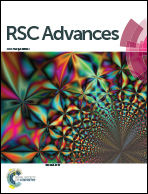Analyte-concentrating 3D hybrid plasmonic nanostructures for use in highly sensitive chemical sensors†
Abstract
We investigated the analyte-concentrating effects of 3D porous Ag hybrid nanostructures that displayed superhydrophobicity toward aqueous solutions and the coffee ring effect toward organic solutions in an effort to develop highly sensitive SERS-based chemical sensors. The 3D hybrid nanostructures were composed of 3D-stacked Ag nanowires (NWs) and nanoparticles (NPs) separated by an alumina interlayer that enhanced plasmonic coupling between the high-density Ag nanomaterials. The antiwetting properties of the 3D plasmonic nanostructures were provided by the specific chemisorption of 1H,1H,2H,2H-perfluorodecanethiol (PFDT) onto the Ag nanomaterials. Synergy between the analyte-enriching effects due to the antiwetting properties and matching of the localized surface plasmon resonance (LSPR) wavelength and the excitation laser wavelength yielded a superhydrophobic 3D porous SERS platform that enabled the ultrasensitive detection of methylene blue in an aqueous solution with a limit of detection (LOD) of 0.15 pM, 104-fold lower than the value obtained from the as-prepared hydrophilic counterparts. Both the PFDT-grafted and as-prepared SERS substrates showed complete wetting with a contact angle (CA) of 0° for organic liquids (i.e., low surface tension liquids), such as acetone. An alternative analyte-concentrating strategy is, therefore, needed for organic solutions. Interestingly, an acetone solution into which had been dissolved a pesticide (iprodione) exhibited a dark ring-shaped concentrated deposit after liquid evaporation, normally known as the coffee ring effect. The SERS intensity line profiles of the iprodione molecules exhibited a 5.7-fold signal enhancement at the ring edge compared to the ring center. The detection of toxins in dissolved organic liquids may be achieved using the coffee ring effect of the 3D porous SERS platform to enhance the SERS sensitivity with an LOD of 250 ng for iprodione molecules. This LOD was 102-fold lower than the European regulatory limits (20 μg/1 kg fruits).


 Please wait while we load your content...
Please wait while we load your content...